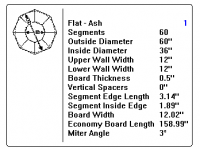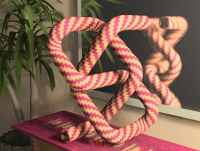I know this is probably a simple math calculation formula, but I'm stumped (probably has to do with age......).
I have several wedgies, I've purchased, but the highest segment number is 48 (3.75 degrees) & I would like to do a wedgie for 60 pieces. I know this would need to be 3 degrees, but I'm not sure how to do the calculation to be able to actually cut a wedgie.
I have a laser and a Shopbot, so I feel confident I can cut the actual wedgie accurately, but I'm stumped with the calculation to draw the actual wedgie in Corel or Aspire.
Hope I'm being clear, any help?
I have several wedgies, I've purchased, but the highest segment number is 48 (3.75 degrees) & I would like to do a wedgie for 60 pieces. I know this would need to be 3 degrees, but I'm not sure how to do the calculation to be able to actually cut a wedgie.
I have a laser and a Shopbot, so I feel confident I can cut the actual wedgie accurately, but I'm stumped with the calculation to draw the actual wedgie in Corel or Aspire.
Hope I'm being clear, any help?


